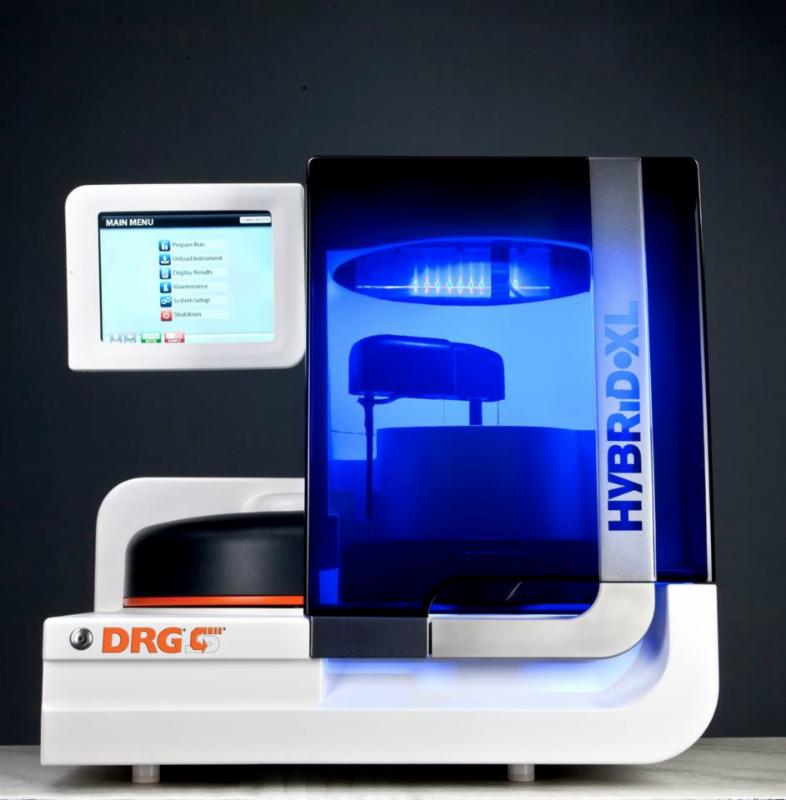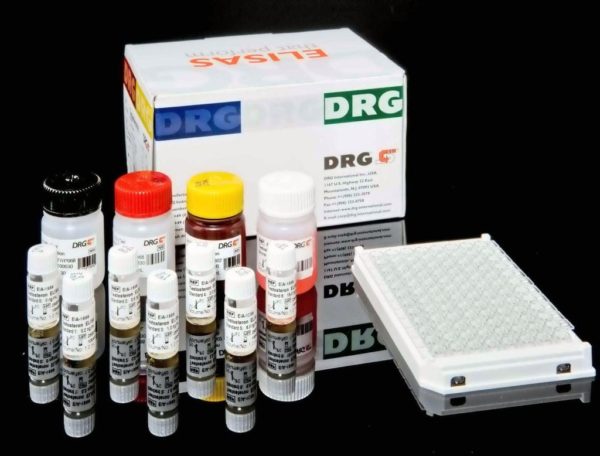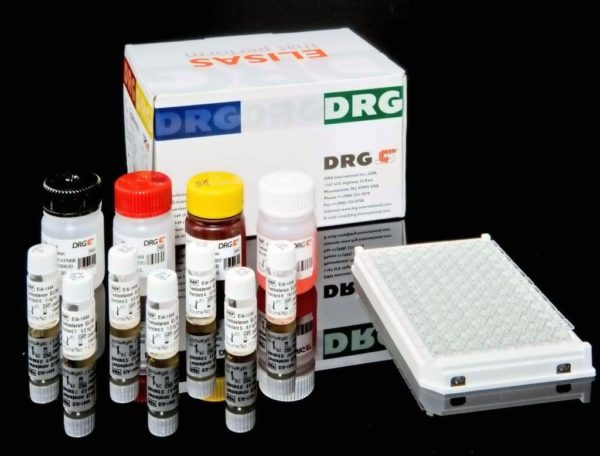Description
The DRG:HYBRiD-XL LH is an enzyme immunoassay for the quantitative in vitro diagnostic measurement of luteinizing hormone (LH) in serum and plasma (EDTA-, heparin- or citrate plasma).
Only for use with the DRG:HYBRiD-XL Analyzer.
- Luteinizing hormone (LH) is produced in both men and women from the anterior pituitary gland in response to luteinizing hormone-releasing hormone (LH-RH or Gn-RH),
which is released by the hypothalamus (1-3). LH, also called interstitial cell-stimulating hormone (ICSH) in men, is a glycoprotein with a molecular weight of approximately 30,000 daltons (4). It is composed of two non covalently associated dissimilar amino acid chains, alpha and beta (5). The alpha chain is similar to that found in human thyroid-stimulating hormone (TSH), follicle stimulating hormone (FSH), and human chorionic gonadotropin (hCG), while the beta subunits differ, which accounts for their immunological differentiation (6-8). The basal secretion of LH in men is episodic and has the primary function of stimulating the interstitial cells (Leydig cells) to produce androgenic hormone. - The primary and most well-known androgen is testosterone. The variation in LH concentrations in women is subject to the complex ovulatory cycle of healthy menstruating women, and depends upon a sequence of hormonal events along the gonado-hypothalamic-pituitary axis. The decrease in progesterone and estradiol levels from the preceeding ovulation initiates each menstrual cycle (9,10). As a result of the decrease in hormone levels, the hypothalamus increases the secretion of gonadotropin-releasing factors (GnRF), which in turn stimulates the pituitary to increase FSH production and secretion (4). Increasing FSH levels stimulate several follicles during the follicular phase, one of these will mature to contain the egg. As the follicle develops, estradiol secretion rises constantly, peaking on day 12 or 13 of a normal cycle. LH is released as a result of high estradiol levels because of direct stimulation of the pituitary and increasing GnRF and FSH levels. These events constitute the pre-ovulatory phase (11). Ovulation occurs approximately 12 to 18 hours after the LH reaches a maximum level.
- After the egg is released, corpus luteum is formed which secretes progesterone and estrogen – two feedback regulators of LH (3,10). The luteal phase rapidly follows this ovulatory phase, and is characterized by high progesterone levels, a second estradiol increase, and low LH and FSH levels (12). Low LH and FSH levels are the result of the negative feedback effects of estradiol and progesterone on the hypotalamic-pituitary axis. After conception, the developing embryo produces hCG, which causes the corpus luteum to continue producing progesterone and estradiol. The corpus luteum regresses if pregnancy does not occur, and the corresponding drop in progesterone and estradiol levels results in menstruation.
- The hypothalamus initiates the menstrual cycle again as a result of these low hormone levels (12). Patients suffering from hypogonadism show increased concentrations of serum LH. A decrease in steroid hormone production in females is a result of immature ovaries, primary ovarian failure, polycystic ovary disease, or menopause; in these cases, LH secretion is not regulated (10,13). A similar loss of regulatory hormones occurs in males when the testes develop abnormally or in anorchia. High concentrations of LH may also be found in primary testicular failure and Klinefelter syndrome, although LH levels will not necessarily be elevated if the secretion of androgens continues. Increased concentrations of LH are also present during renal failure, cirrhosis, hyperthyroidism, and severe starvation (10,14). A lack of secretion by the anterior pituitary may cause lower LH levels. As may be expected, low levels may result in infertility in both males and females. Low levels of LH may also be due to the decreased secretion of GnRH by the hypothalamus, although the same effect may be seen by a failure of the anterior pituitary to respond to GnRH stimulation.
- Low LH values may therefore indicate some dysfunction of the pituitary or hypothalamus, but the actual source of the problem must be confirmed by other tests (10). In the differential diagnosis of hypothalamic, pituitary, or gonadal dysfunction, assays of LH concentration are routinely performed in conjunction with FSH assays since their roles are closely interrelated. Furthermore, the hormone levels are used to determine menopause, pinpoint ovulation, and monitor endocrine therapy.
- The DRG:HYBRiD-XL LH Kit is a solid phase enzyme-linked immunosorbent assay (ELISA) based on the sandwich principle. The antibody coated wells (ACW) of the reagent cartridges are coated with a monoclonal (mouse) antibody directed towards a unique antigenic site of the LH molecule. An aliquot of patient sample containing endogenous LH is incubated in the coated well with enzyme conjugate, which is an anti-LH antibody conjugated with biotin (Enzyme Conjugate). After incubation the unbound conjugate is washed off. Bound biotinylated antibodies are detected by consequent incubation of enzyme complex (Enzyme Complex), which is Streptavidin-HRP. After washing off unbound complex, TMB substrate is added. The intensity of colour developed is proportional to the concentration of LH in the patient sample.




